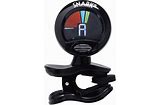Guitar tablature, or “tab,” is a music notation system that uses six horizontal lines to represent the strings of your guitar. The bottom lines are your bass strings, the top lines are your treble strings. Numbers are placed on the lines to show which frets to play on which strings, and you read them left to right. The order of the strings looks upside-down to a lot of people at first, but you get used to it.
Example #1
E(1st)- - - - - - - - - - - - - - - - - - - - - - - - - -
B(2nd- - - - - - - - - - - - - - - - - - - - - - - - - -
G(3rd)- - - - - - - - - - - - - - - - - - - - - - - - -
D(4th)- - - - - - - - - - - - - - - - - - - - - - - - -
A(5th) - - - - - - - - - - - - - - - - - - - - - - - - -
E(6th)- - - - 0- - 3- - 5- - - - - 0- -3 - 6- 5- -
In the example above, you are playing notes on your low E string (the 6th string). You start on the open string (“0”), then play the 3rd fret, then the 5th fret, and so on. This example should sound like “Smoke on the Water,” by Deep Purple.
Example #2
E(1st)- - - 3- - - - - - - - - - - - - - - -
B(2nd- - - -0 - - - - - - - - - - - - - - - -
G(3rd)- - - 0- - - - - - - - - - - - - - - - -
D(4th)- - - 0- - - - - - - - - - - - - - - - -
A(5th) - - -2 - - - - - - - - - - - - - - - -
E(6th)- - - 3- - - - - - - - - - - - - - - -
When you see notes aligned vertically, it means to set up all the notes and then strum them simultaneously. In this example, it’s a G chord.
Example #3
E(1st)- - - - - - - - - - - - - -3 - - - - - - - - - - - -
B(2nd- - - - - - - - - - - - -0 - - - - - - - - - - - - -
G(3rd)- - - - - - - - - - 0- - - - - - - - - - - - - - -
D(4th)- - - - - - - - 0- - - - - - - - - - - - - - - - -
A(5th) - - - - - -2 - - - - - - - - - - - - - - - - - - -
E(6th)- - - - 3- - - - - - - - - - - - - - -
Here we’re playing one note at a time, starting on the 6th string (your lowest bass string) and moving up one string at a time. It can help to look at the frets and try to figure out if a familiar chord is being spelled out by the numbers. In this case, it’s the G chord again.
Fingerings
Guitar tab does a good job of telling you which strings and which frets to play, but it doesn’t tell you which fingers to use, so you have to experiment with different fingers until you find a fingering that’s efficient. Once again, it’s really helpful if you can spot when scale and chord shapes you already know are being used.
Rhythms & Using Your Ear
Basic tablature doesn’t usually indicate the exact rhythm, just the order of the notes, so you’ll need to consult recordings to really get a feel for the timing. While there are more complicated versions of tablature out there that do include rhythm notation, in my opinion, it’s more important to develop your ability to listen closely and then use basic tab to give you a starting point when you’re learning a song.
This is especially important when browsing user-generated tabs online, since they may not be totally accurate. You don’t want to spend hours learning from a tab, only to find it doesn’t sound right when you play along with the original recording.
It’s a tough call sometimes, since maybe it’s the tab that’s not correct, or maybe you’re just not playing it right! When I’m learning a song I’ve always wanted to learn and it’s important to me, I usually buy an official “Recorded Versions” tab book so I can be sure of its accuracy. It’s worth thirty bucks for the peace of mind, plus you usually get an album’s worth of songs.
Conclusion
All notation systems take some getting used to, whether we’re talking about tablature, standard sheet music, chord charts, or the scribbled song structure diagram your bass player hands you at rehearsal. Tab is a great tool for learning riffs and picking patterns quickly, and like everything in guitar playing, you use your ears, your eyes, and your fingers together to make the sounds you want.

 3/4 Size
3/4 Size